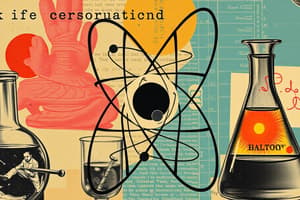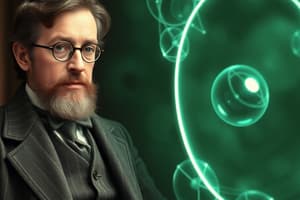Podcast
Questions and Answers
How can the number of neutrons in an atom be calculated?
How can the number of neutrons in an atom be calculated?
- By adding the number of protons to the atomic number
- By subtracting the atomic number from the number of electrons
- By multiplying the atomic number by the mass number
- By subtracting the number of protons from the mass number (correct)
What is the empirical formula for glucose (C6H12O6)?
What is the empirical formula for glucose (C6H12O6)?
- CH2O (correct)
- C3H6O3
- C1H2O1
- C2H4O2
Which of the following describes a cation?
Which of the following describes a cation?
- An atom that has gained electrons
- An ion with a negative charge
- An atom that has lost electrons (correct)
- An atom that has a balanced charge
Which of the following molecules is considered a diatomic molecule?
Which of the following molecules is considered a diatomic molecule?
Which of these substances is correctly identified as a compound?
Which of these substances is correctly identified as a compound?
What defines an ion?
What defines an ion?
Which chemical formula represents a molecular compound?
Which chemical formula represents a molecular compound?
What is the atomic number of an element a measure of?
What is the atomic number of an element a measure of?
What is the correct formula for the ionic compound formed between potassium and bromine?
What is the correct formula for the ionic compound formed between potassium and bromine?
What is the primary characteristic of the Plum Pudding Model proposed by J.J. Thomson?
What is the primary characteristic of the Plum Pudding Model proposed by J.J. Thomson?
Which systematic name corresponds to the compound Mg(OH)2?
Which systematic name corresponds to the compound Mg(OH)2?
What does the Stock System help identify in chemical compounds?
What does the Stock System help identify in chemical compounds?
Which scientist proposed that electrons occupy discrete orbits and do not radiate energy while in those orbits?
Which scientist proposed that electrons occupy discrete orbits and do not radiate energy while in those orbits?
What is a key feature of alkali metals in Group 1 of the periodic table?
What is a key feature of alkali metals in Group 1 of the periodic table?
What is the defining characteristic of non-metals compared to metals?
What is the defining characteristic of non-metals compared to metals?
What is the name of the binary acid H2S?
What is the name of the binary acid H2S?
Which of the following represents a molecular compound?
Which of the following represents a molecular compound?
What is a unique characteristic of noble gases?
What is a unique characteristic of noble gases?
Which of the following statements about metals is correct?
Which of the following statements about metals is correct?
How can metalloids be distinguished from both metals and nonmetals?
How can metalloids be distinguished from both metals and nonmetals?
Which term describes elements with similar chemical and physical properties arranged in a systematic way?
Which term describes elements with similar chemical and physical properties arranged in a systematic way?
What is the correct name for BaCl2?
What is the correct name for BaCl2?
What discovery is Ernest Rutherford known for in relation to atomic structure?
What discovery is Ernest Rutherford known for in relation to atomic structure?
What defines the atomic number of an element?
What defines the atomic number of an element?
Which prefix is used in the naming of the compound N2O4?
Which prefix is used in the naming of the compound N2O4?
What is the average atomic mass of an element calculated from?
What is the average atomic mass of an element calculated from?
What characterizes oxyacids in terms of their composition?
What characterizes oxyacids in terms of their composition?
What was a major implication of John Dalton's atomic theory regarding elements and compounds?
What was a major implication of John Dalton's atomic theory regarding elements and compounds?
If an element has natural abundances of 90.92% with 19.99 amu, 0.26% with 20.99 amu, and 8.82% with 21.99 amu, what is primarily used to determine the average atomic mass of this element?
If an element has natural abundances of 90.92% with 19.99 amu, 0.26% with 20.99 amu, and 8.82% with 21.99 amu, what is primarily used to determine the average atomic mass of this element?
What are neutrons, as discovered by James Chadwick?
What are neutrons, as discovered by James Chadwick?
Which statement is true about isotopes?
Which statement is true about isotopes?
What is true about chlorine and its isotopes?
What is true about chlorine and its isotopes?
What is the systematic name for HCl?
What is the systematic name for HCl?
What is the systematic name for H2S?
What is the systematic name for H2S?
Which naming convention applies if an oxyanion ends in -ate?
Which naming convention applies if an oxyanion ends in -ate?
What is the systematic name for HNO2?
What is the systematic name for HNO2?
Which of the following correctly describes a base?
Which of the following correctly describes a base?
What is the systematic name for BaCl2 · 2H2O?
What is the systematic name for BaCl2 · 2H2O?
What type of hydrocarbon has a benzene ring structure?
What type of hydrocarbon has a benzene ring structure?
When naming hydrocarbons, what does the suffix -ene indicate?
When naming hydrocarbons, what does the suffix -ene indicate?
Flashcards are hidden until you start studying
Study Notes
Early Atomic Models & Discoveries
- John Dalton: proposed the atomic theory, which stated that elements are made up of atoms, atoms of the same element are identical, and atoms of different elements have different masses.
- J. J. Thomson: discovered electrons and proposed the plum pudding model, which suggested that atoms are positive spheres with negatively charged electrons embedded in them.
- Ernest Rutherford: discovered the nucleus of an atom through his gold foil experiment, which showed that positively charged alpha particles were deflected by a concentrated positive charge within the atom.
- James Chadwick: discovered neutrons, which are particles with no charge and a mass similar to protons, found in the nucleus of an atom.
- Niels Bohr: proposed the Bohr model, which stated that electrons occupy specific energy levels or orbits around the nucleus, and they do not radiate energy while in these orbits.
Periodic Table
- The periodic table arranges elements based on their atomic number and recurring chemical properties.
- It allows us to predict the properties of elements based on their position on the table.
- The periodic table is divided into groups (columns), periods (rows), and blocks.
Metals, Nonmetals, and Metalloids
- Metals: good conductors of heat and electricity, malleable (can be hammered into sheets), ductile (can be drawn into wires), and most are solids at room temperature.
- Nonmetals: poor conductors of heat and electricity, not malleable or ductile, and vary in state (gas, liquid, or solid) at room temperature.
- Metalloids: have properties between metals and nonmetals, often used as semiconductors.
Group Classifications
- Group 1 (Alkali Metals): highly reactive metals forming alkalis (strong bases) when reacting with water.
- Group 2 (Alkaline Earth Metals): reactive metals forming alkaline earths (oxides that form strong bases).
- Group 17 (Halogens): reactive nonmetals producing salts.
- Group 18 (Noble Gases): inert gases existing as single atoms.
Atomic Structure Terms
- Atomic Number: the number of protons in an atom, defining the element's chemical identity.
- Mass Number: the sum of protons and neutrons in the nucleus of an atom.
- Isotopes: atoms of the same element with different numbers of neutrons in their nuclei, leading to different mass numbers.
- Average Atomic Mass: the weighted average of the masses of all isotopes of an element, accounting for their natural abundance.
Ionic Compounds
- Ionic compounds are formed between a metal cation and a nonmetal anion.
- The charges of the cation and anion must balance to form an electrically neutral compound.
Nomenclature: Naming Compounds
- Ionic Compounds: name the cation followed by the anion, with the anion's name ending in "ide".
- Molecular Compounds: use prefixes to indicate the number of atoms of each element, followed by the name of the second element ending in "ide".
- Acids: binary acids start with "hydro" followed by the nonmetal's name ending in "ic acid".
- Oxyacids: named based on the oxyanion; "-ite" endings for oxyacids mean "-ous acid", while "-ate" endings mean "-ic acid".
- Bases: named by adding "hydroxide" to the cation's name.
- Hydrates: named with the compound's name followed by a prefix indicating the number of water molecules, ending in "hydrate."
Organic Chemistry
- Hydrocarbons: simplest organic compounds containing only carbon and hydrogen atoms.
- Aliphatic Hydrocarbons: form straight chains of carbon atoms.
- Alicyclic Hydrocarbons: form rings of carbon atoms.
- Aromatic Hydrocarbons: contain a benzene ring (C6H6), a special structure.
Naming Hydrocarbons
- The name is based on the length of the longest carbon chain (main chain).
- The end of the name indicates the type of bond: "-ane" for single bonds, "-ene" for double bonds, and "-yne" for triple bonds.
- Branch chains are named with the prefix "-yl" and their position on the main chain is indicated by a number.
Studying That Suits You
Use AI to generate personalized quizzes and flashcards to suit your learning preferences.




